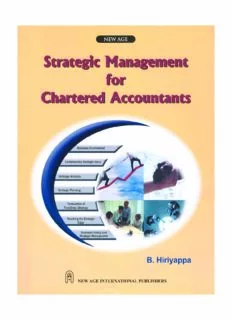
Strategic Management for Chartered Accountants PDF
Preview Strategic Management for Chartered Accountants
This page intentionally left blank Copyright © 2008, New Age International (P) Ltd., Publishers Published by New Age International (P) Ltd., Publishers All rights reserved. No part of this ebook may be reproduced in any form, by photostat, microfilm, xerography, or any other means, or incorporated into any information retrieval system, electronic or mechanical, without the written permission of the publisher. All inquiries should be emailed to [email protected] ISBN (13) : 978-81-224-2538-3 PUBLISHING FOR ONE WORLD NEW AGE INTERNATIONAL (P) LIMITED, PUBLISHERS 4835/24, Ansari Road, Daryaganj, New Delhi - 110002 Visit us at www.newagepublishers.com Preface Strategic management is a stream of decisions and actions with view to develop effective long term and short term planning and policies with technological business forecasting that would help the organization achieve its superior goal. Strategic management includes strategic analysis, strategy formulation, strategic choice, strategy implementation and control strategic decision for an organization to deploy resources into new opportunities. Strategic management is important for Chartered Accountants, CEO, Directors, Managing Directors, Strategy Planners, Students and Faculty Members of BBM, MBA, M.Com, PGDM, PGDBM, PGDHRM, ICFAI and competitive examinations in India and abroad. I invite suggestions from one and all for improvements in next edition of this book. Many individuals have rendered their helping hand to me. I take this opportunity to thank all of them. I thank Dr. D.M. Basvaraja, my teacher, guide and supervisor and professor from Kuvempur University for this constant inspiration and support. I also thank Dr. C.M. Thagaraju, Dr. G.T. Govindappa, my teachers, and professors of Kuvempur University. I am immensely indebted to them. I also thank T.N. Suresh, Director of Padmashree group of institutions, Bangalore, Dr. C.N. Aswathnarayan, Chairman of Padmashree group of institutions, Bangalore, Dr. Bakkappa, Coordinator, Shiva Gangothri PG Centre, Davanagere, Dr. A.Venktaraju, Professor, ATNCC, Shimoga, Prof. Sheshchalla, KKECS, Bangalore, Chairman, Principal, HOD and staff of TIMS, Bangalore, and Prof. Shekappa and my friend Nagaraja A.P. In writing this book I have drawn on a vast amount of literature in strategic management. Naturally, I owe an intellectual debt to numerous authors who have enriched the stream of literature in strategic management by their contributions. My prefounded debt is to American scholars, George Stenier, Ansoff, Newman, Warren, Peter Drucker, Akcoff, Christenson, Kenneth, Bower and Vacil, Acherman, Robinson, Piere, Wheeler and Hunger, Charles W.L. Hill and Gareth R. Jones. In the UK I owe a great debt to Argeni, Hussey, and Barnard Taylor, Thomson and other scholars. Shri Saumya Guptha, MD, Shri Sudarshan S.P., Marketing manager, the New Age International Publisher, these persons are the main initiators and monitors of this project. I express my sincere gratitude to all of them. It is my prime responsibility to thank my parents, brother, sisters and friends for put with inconveniences caused during writing of this book. Dr. B. HIRIYAPPA. Ph. D. Bangalore This page intentionally left blank Contents Preface (v) 1. BUSINESS ENVIRONMENT 1 1.1 Introduction 2 1.2 Definition of Business 3 1.3 Characteristics of Business 5 1.4 Components of Business 5 1.5 Objectives of a Business 7 1.6 Characteristics of Business Environment 11 1.7 Environmental Influences on Business 12 1.8 Environmental Analysis 15 1.9 Components of Business Environment 17 1.10 Relationship Between Organisation and its Environment 17 1.11 Internal Analysis of the Organisation/Company 19 1.12 The Value of Systematic Internal Assessment 20 1.13 Identificaion of Strategic Factors 20 1.14 Evalution of Strategic Internal Factors 26 1.15 External Environment 29 1.16 Economic Environment 35 1.17 Political-Legal Environment 37 1.18 Socio–Cultural Environment 38 1.19 Demographic Environment 39 1.20 Natural Environment 41 1.21 Technological Environment 42 1.22 Global Environment 44 1.23 Strategic Response to the Environment 49 1.24 Competitive Environment 50 1.25 Competitive Advantage 52 viii Contents 2. BUSINESS POLICY AND STRATEGIC MANAGEMENT 64 2.1 Introduction 64 2.2 Business Policy as a Discipline 64 2.3 Importance of Business Policy 65 2.4 Classification of Business Policy 66 2.5 Definition of Strategy 73 2.6 Generic Strategic Alternatives 81 2.7 The Dynamics of Competitive Strategy 85 2.8 Meaning of Strategic Management 86 2.9 Dimensions of Strategic Decisions 90 2.10 Tasks in Strategic Management 91 2.11 Strategic Management Model 92 2.12 Vision, Mission and Objectives 93 2.13 The Need for explicit Mission of Organization 96 2.14 Defining Organisation Mission 97 3. STRATEGIC ANALYSIS 106 3.1 Introduction 106 3.2 Strategic Analysis 106 3.3 Issues to Consider For Strategic Analysis 107 3.4 Situational Analysis 109 3.5 The Methods of Industry and Competitive Analysis 112 3.6 Strategic Groups 116 3.7 Key Factors for Competitive Success 117 3.8 Swot Analysis 120 3.9 Tows Matrix Analysis 126 3.10 Portfolio Analyses 127 3.11 Strategic Business Units 128 3.12 Stages in Product/Market Evolution or Product Life Cycle 129 3.13 BCG Matrix 130 3.14 ADL Matrix 136 3.15 The General Elective Model 137 4. STRATEGIC PLANNING 142 4.1 Corporate Strategy 142 4.2 The Stages of Corporate Strategy Formulation–Implementation Process 145 Contents ix 4.3 Strategic Alternatives 156 4.4 Cost Leadership Strategies 158 4.5 Differentiation Strategy 159 4.6 Focus Strategy 161 4.7 Characteristics and Scope of various Grand Strategies 167 4.8 Diversification 172 4.9 Retrenchment, Divestment and Liquadation Stralegy 180 4.10 Turnaround Strategy 180 4.11 The Causes of Corporate Decline 181 4.12 Divestment/Cutback Strategy 185 5. FORMULATION OF FUNCTIONAL STRATEGY 189 5.1 Introduction 190 5.2 Marketing Strategy Formualation 191 5.3 Developing the Marketing Mix 193 5.4 Dealing with the Marketing Environment 196 5.5 Marketing Strategy Techniques 197 5.6 Financial Strategy Formulation 200 5.7 Production Strategy Formulation 206 5.8 Logistics Strategy 207 5.9 Research and Development Strategy 208 5.10 Human Resource Strategy 211 6. FORMULATION OF FUNCTIONAL STRATEGY 219 6.1 Introduction 221 6.2 Interrelationships between Strategy Formulation and Implementation 221 6.3 Issues in Strategy Implementation 227 6.4 Organization and Strategy Implementation 230 6.5 Implementing Strategic Change: Steps in the Changing Process 232 6.6 Vertical Differentiation 236 6.7 Horizontal Differentiation 238 6.8 Strategic Business Units 244 6.9 Matrix Organizational Structure 245 6.10 Integration and Integrating Mechanisms 249 6.11 Multidomestic Strategy and Structure 252
Description: